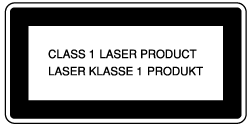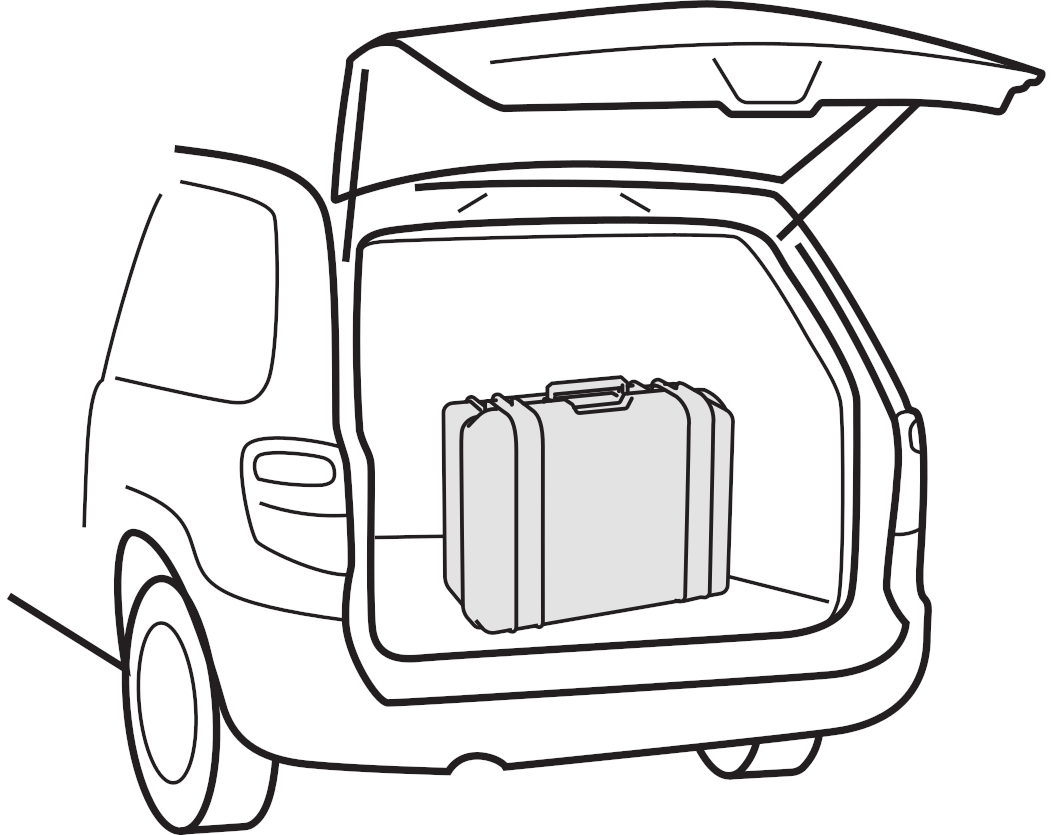Safety and Handling Information¶
Safety Information¶
It is important to read all the safety information before starting to use your new Leo scanner. If you don’t follow these instructions, damage, injury, or malfunction may happen.
Become familiar with the following safety messaging conventions used throughout this manual.
Warning
Warns you about actions that could result in personal injury.
Caution
Cautions you about actions that may result in malfunctions or physical damage to Artec Leo scanner.
Attention
General important information.
Laser Exposure¶
Artec Leo scanner is a device that is safe both for an operator and a subject of scanning under conditions of its intended use. In accordance with EN 60825-1:2014, the Artec Leo 3D Scanner is to be classified as a Laser Class 1 product when used as intended.
Complies with 21 CFR 1040.10 and 1040.11 except for conformance with IEC 60825-1 Ed. 3., as described in Laser Notice No. 56, dated May 8, 2019.
It is thereby confirmed that Leo is compliant with all the standard safety requirements and is safe for end users. Class 1 laser product means that the device is safe regardless of the distance to the laser aperture.

Warning
Avoid looking into the scanner lens from the distance lower than 35 centimeters.
Leo has an additional protection system that halts the laser light if the distance between the device and the object becomes lower than 10 centimeters.
Warning
Never attempt to disassemble the scanner. The laser source inside the device can cause eye injury if the device is operated in a disassembled or modified state. Only authorized ARTEC EUROPE S.à r.l. personnel can perform service operations.
Wireless Network Usage¶
Scanner uses radio signals to connect to Wi-Fi networks. You must observe regulations that forbid the use of electronic device in some facilities. Turn off Wi-Fi in the scanner settings to this end.
Electrical Safety¶
To avoid electrical shock, use Leo in dry environment (see Operating Temperature and Humidity for details).
Warning
Never open scanner housing or insert foreign object into its openings.
Power Supply and Cables¶
Use only power adapters and cables intended for Leo scanner and supplied by ARTEC EUROPE S.à r.l..
Caution
Using the DC cables and power adapters intended for Artec Eva or other scanners may lead to malfunction of Leo scanner.
Before you plug the power cord into a power outlet, check the connection in the locations:
Protect the cables from being trodden on or being squashed.
Protect the openings from foreign objects or dripping liquids.
Place power supply unit on a stable surface. A drop or fall could cause damage.
Always check all the cables for damages.
Battery Usage¶
Use only batteries, cables and charging devices intended for Leo and supplied by ARTEC EUROPE S.à r.l..
Warning
Do not immerse a battery into fire and do not puncture it.
Avoid discharging scanner battery completely. Watch the battery charge level: the  icon at the top of the screen shows it.
icon at the top of the screen shows it.
Caution
Never store Leo with a discharged battery. If the scanner is to go unused for long periods, charge the battery at least once every three months.
Avoid prolonged battery depletion. Charge the battery regularly, even if the scanner is not in use. If left uncharged for an extended period, the battery may become completely depleted and will no longer hold a charge.
Caution
Never leave the battery uncharged for long periods. Charge it at least once every three months to maintain its capacity. Battery replacement is not available.
Handling Information¶
Artec Leo is an instrument that contains sophisticated optical and computing systems. Handle it with care, avoid jolting and inflicting any impact or pressure on the device.
Caution
Always grip the scanner by its handle; use your other hand for extra support when necessary. Gripping only the scanner head or battery housing may lead to device malfunction.

Optical Parts¶
We strongly advise that you refrain from touching the optical parts of the scanner. Use a blower to remove dust from the lens. If a grease spot adheres to the lens or other optical parts, wipe it with a lens cloth.

Caution
Do not use cleaners that contain organic solvents to clean the lens.
Operating Temperature and Humidity¶
Artec Leo is designed to function in ambient temperatures between +15°С and +35°С (59°F and 95°F) and humidity of up to 80%. Avoid exposure to condensation.
When you are using the scanner, it is normal for it to get warm. Artec Leo may, however, fail to function if the device can’t regulate its internal temperature. Wait for a few minutes before trying to scan again.
Exposure to Liquid and Dust¶
Avoid direct exposure to any liquid or dust as it could lead to deterioration in the device’s performance. If your scanner has been exposed to liquid, turn it off and unplug power cable. To dry the device, use soft cloth.

Transportation and Storage¶
When transporting your Leo, do so only using the hard case. The Artec Leo case has been specially engineered and thoroughly impact tested by ARTEC EUROPE S.à r.l. in order to protect the device from any external damage during shipping or transportation.

Leo case has foam sections designed to store scanner’s original and optional accessories. Don’t store any extraneous items in this case. Don’t alter the case or remove any foam sections.
When not using your scanner, please keep it safely stored in the hard case.
Caution
Never turn on the scanner while it is stored in the hard case. It may cause overheating.
For cargo shipping, we suggest using the original wooden box your scanner arrived in. Before putting the hard case in the box, ensure all foam sections are correctly installed. Safely store this box for future use; don’t discard it.

Batteries¶
When transporting spare batteries for Leo, ensure that you observe regulations of your air or transport carrier.
Disassembling and Repair¶
Do not try to open the scanner, remove any of its parts or tamper with it any other way. This may lead to malfunction of the device or even cause harm to human health (see Laser Exposure). The only allowed operation for a user is the battery replacement in the battery compartment.
All the maintenance and repair procedures are only carried out by the manufacturer.
Manufacturer’s Address¶
ARTEC EUROPE S.á r.l.
4 Rue Lou Hemmer, L-1748
Senningerberg, Luxembourg
Factory’s Address¶
ARTEC EUROPE S.á r.l.
11 Breedewues, L-1259
Senningerberg, Luxembourg
Compliance¶
Leo is compliant with the regulations stated in this section.
European Union¶

ARTEC EUROPE S.à r.l. declares that Artec Leo meets the provision of the following Directives:
2014/53/EU The Radio Equipment Directive (RED)
2014/35/EU The Low Voltage Directive (LVD)
2014/30/EU The Electromagnetic Compatibility Directive (EMC)
2011/65/EU The Restriction of Hazardous Substances Directive (RoHS)
2012/19/EU The Waste Electrical and Electronic Equipment (WEEE)
and complies with the following standards:
|
|
|
United States¶
Federal Communication Commission (FCC)¶

This device complies with part 15 of the FCC Rules. Operation is subject to the following two conditions: (1) This device may not cause harmful interference, and (2) this device must accept any interference received, including interference that may cause undesired operation.
This equipment has been tested and found to comply with the limits for a Class B digital device, pursuant to part 15 of the FCC Rules. These limits are designed to provide reasonable protection against harmful interference in a residential installation. This equipment generates, uses, and can radiate radio frequency energy and, if not installed and used in accordance with the instructions, may cause harmful interference to radio communications. However, there is no guarantee that interference will not occur in a particular installation.
If this equipment does cause harmful interference to radio or television reception, which can be determined by turning the equipment off and on, the user is encouraged to try to correct the interference by one or more of the following measures:
Reorient or relocate the receiving antenna.
Increase the separation between the equipment and receiver.
Connect the equipment to an outlet on a circuit different from that to which the receiver is connected.
Consult the dealer or an experienced radio/TV technician for help.
Important
Changes or modifications to this device not authorized by ARTEC EUROPE S.à r.l. could void the electromagnetic compatibility (EMC) and wireless compliance and negate your authority to operate the product.
Caution
Use the interface cables sold or provided by Artec for this device. Using other interface cable may exceed the limits of Class B Part 15 of the FCC rules.
FCC RF Radiation Exposure Statement¶
This Transmitter must not be co-located or operating in conjunction with any other antenna or transmitter.
Artec LEO is a Portable device for body worn operation, this device has been tested and meets FCC RF exposure guidelines. When used with an accessory that contains metal may not ensure compliance with FCC RF exposure guidelines.
To get access to the Regulatory information that includes E-labels, go to Settings → Account → Regulatory.
Food and Drug Administration (FDA)¶
Complies with 21 CFR 1040.10 and 1040.11 except for conformance with IEC 60825-1 Ed. 3., as described in Laser Notice No. 56, dated May 8, 2019.
Canada¶
Contains IC: 7361A-P2180.
This device contains licence-exempt transmitter(s)/receiver(s) that comply with Innovation, Science and Economic Development Canada’s licence-exempt RSS(s). Operation is subject to the following two conditions: 1. This device may not cause interference, and 2. This device must accept any interference, including interference that may cause undesired operation of the device.
L’émetteur/récepteur exempt de licence contenu dans le présent appareil est conforme aux CNR d’Innovation, Sciences et Développement économique Canada applicables aux appareils radio exempts de licence. L’exploitation est autorisée aux deux conditions suivantes : 1. l’appareil ne doit pas produire de brouillage, et 2. l’utilisateur de l’appareil doit accepter tout brouillage radioelectrique subi, meme si le brouillage est susceptible d’en compromettre le fonctionnement.
Exposure to Radio Frequency Radiation¶
Caution
To comply with the Canadian RF exposure compliance requirements, this device and its antenna must not be co-located or operating in conjunction with any other antenna or transmitter.
Caution
Pour se conformer aux exigences de conformité RF canadienne l’exposition, cet appareil et son antenne ne doivent pas être co-localisés ou fonctionnant en conjonction avec une autre antenne ou transmetteur.
Portable Device Caution¶
Caution
For portable operation, this device has been tested and meets RF exposure guidelines when used with an accessory that contains no metal. Use of other accessories may not ensure compliance with RF exposure guidelines.
Caution
Pour portable utilisation, cet appareil a été testé et respecte les directives sur l’exposition aux RF lorsqu’il est utilisé avec un accessoire sans métal. L’utilisation d’autres accessoires peut ne pas garantir la conformité aux directives d’exposition aux RF.
Environmental Disclosures¶
California Prop 65 Warning — California law requires this warning to be provided to California customers.
Prop 65 Warning: This product contains chemicals known to the State of California to cause cancer and birth defects or other reproductive harm.
Disposal Information¶

The symbol above means that Artec Leo and/or its battery meets the European Directive 2002/96/EC on Waste Electrical and Electronic Equipment. This symbol indicates that when product reaches the end of its life, it should be taken to a collection point designated by local authorities. The separate collection and recycling of your scanner and/or its battery at the time of disposal will help preserve natural resources and ensure it is recycled in a way that protects human health and environment.
